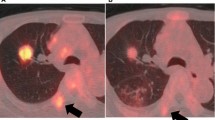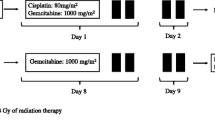Abstract
Purpose
To test the performance of sequential 18F-fluorodeoxyglucose positron emission tomography/computed tomography (FDG-PET/CT) in predicting survival after sunitinib therapies in patients with cancer of unknown primary (CUP).
Methods
CUP patients were enrolled for sequential PET/CT scanning for sunitinib and a control group. Univariate and multivariate analysis were applied to test the efficacy of sunitinib therapy in CUP patients. Next, sequential analyses involving PET/CT parameters were performed to identify and validate sensitive PET/CT biomarkers for sunitinib therapy. Finally, time-dependent receiver operating characteristic (TDROC) analyses were performed to compare the predictive accuracy.
Results
Multivariate analysis proved that sunitinib group had significantly improved survival (p < 0.01) as compared to control group. After cycle 2 of therapy, multivariate analysis identified volume-based PET/CT parameters as sensitive biomarkers for sunitinib (p < 0.01). TDROC curves demonstrated whole-body total lesion glycolysis reduction (Δ WTLG) and follow-up WTLG to have good accuracy for efficacy prediction. This evidence was validated after cycle 4 of therapy with the same method.
Conclusion
Sunitinib therapy proved effective in treatment of CUP. PET/CT volume-based parameters may help predict outcome of sunitinib therapy, in which Δ WTLG and follow-up WTLG seem to be sensitive biomarkers for sunitinib efficacy. Patients with greater reduction and lower WTLG at follow-up seem to have better survival outcome.


Similar content being viewed by others
References
Varadhachary GR, Raber MN. Cancer of unknown primary site. N Engl J Med. 2014;371(8):757–65.
Briasoulis E, Tolis C, Bergh J, Pavlidis N. ESMO minimum clinical recommendations for diagnosis, treatment and follow-up of cancers of unknown primary site (CUP). Ann Oncol. 2005;16 Suppl 1:i75–6.
Pavlidis N, Pentheroudakis G. Cancer of unknown primary site. Lancet. 2012;379:1428–35.
Golfinopoulos V, Pentheroudakis G, Salanti G, Nearchou AD, Ioannidis JP, Pavlidis N. Comparative survival with diverse chemotherapy regimens for cancer of unknown primary site: multiple-treatments meta-analysis. Cancer Treat Rev. 2009;35:570–3.
Greco FA, Pavlidis N. Treatment for patients with unknown primary carcinoma and unfavorable prognostic factors. Semin Oncol. 2009;36:65–74.
Greco FA, Hainsworth JD. Cancer of unknown primary site. In: DeVita Jr VT, Hellman S, Rosenberg SA, editors. Cancer: principles and practice of oncology. 8th ed. Philadelphia: Lippincott Williams & Wilkins; 2008. p. 2363–87.
Motzer RJ, Rini BI, Bukowski RM, et al. Sunitinib in patients with metastatic renal cell carcinoma. JAMA. 2006;295:2516–24.
George S, Blay JY, Casali PG, et al. Clinical evaluation of continuous daily dosing of sunitinib malate in patients with advanced gastrointestinal stromal tumour after imatinib failure. Eur J Cancer. 2009;45:1959–68.
Castellano D et al. Therapy management with sunitinib in patients with metastatic renal cell carcinoma: key concepts and the impact of clinical biomarkers. Cancer Treat Rev. 2013;39:230–40.
Imbulgoda A et al. Sunitinib in the treatment of advanced solid tumors. Small Mol Oncol. 2014;13:165–78.
Thézé B, Bernards N, et al. Monitoring therapeutic efficacy of sunitinib using [18F]FDG and [18F]FMISO PET in an immunocompetent model of luminal B (HER2-positive)-type mammary carcinoma. BMC Cancer. 2015;15:534–8.
Kayani I, Avril N, Bomanji J, Chowdhury S, Rockall A, Sahdev A, et al. Sequential FDG-PET/CT as a biomarker of response to sunitinib in metastatic clear cell renal cancer. Clin Cancer Res. 2011;17(18):6021–8.
Vesselle H, Freeman JD, Wiens L, et al. Fluorodeoxyglucose uptake of primary non–small cell lung cancer at positron emission tomography: new contrary data on prognostic role. Clin Cancer Res. 2007;13(11):3255–63.
Chung MK, Jeong HS, Park SG, et al. Metabolic tumor volume of [18F]- fluorodeoxyglucose positron emission tomography/computed tomography predicts short-term outcome to radiotherapy with or without chemotherapy in pharyngeal cancer. Clin Cancer Res. 2009;15:5861–8.
Vesselle H, Schmidt RA, Pugsley JM, et al. Lung cancer proliferation correlates with [F-18] fluorodeoxyglucose uptake by positron emission tomography. Clin Cancer Res. 2000;6(10):3837–44.
Tang Y et al. Effect of surgery on quality of life of patients with spinal metastasis from non-small-cell lung cancer. J Bone Joint Surg Am. 2016;98:396–402.
Pfizer Inc. SUTENT, Summary of product characteristics.http://www.ema.europa.eu/humandocs/PDFs/EPAR/sutent/emea-combined-h687en.pdf July 2010.
Maita S, Yuasa T, et al. Antitumor effect of sunitinib against skeletal metastatic renal cell carcinoma through inhibition of osteoclast function. Int J Cancer. 2012;130:677–84.
Satoh Y, Onishi H, Nambu A, Araki T. Volume-based parameters measured by using FDG PET/CT in patients with stage I NSCLC treated with stereotactic body radiation therapy: prognostic value. Radiology. 2014;270(1):275–81.
Satoh et al. Whole-body total lesion glycolysis measured on fluorodeoxyglucose positron emission tomography/computed tomography as a prognostic variable in metastatic breast cancer. BMC Cancer. 2014,14:525.
Kaplan EL, Meier P. Non parametric estimation from incomplete observations. J Am Stat Assoc. 1958;53:457–81.
Hyun SH, Choi JY, Kim K, Kim J, Shim YM, Um SW, et al. Volume-based parameters of 18F-fluorodeoxyglucose positron emission tomography/computed tomography improve outcome prediction in early-stage non–small cell lung cancer after surgical resection. Ann Surg. 2013;257(2):364–70.
Cox DR. Regression models and life tables. J R Stat Soc. 1972;34:187–220.
Heagerty PJ, Lumley T, Pepe MS. Time-dependent ROC curves for censored survival data and a diagnostic marker. Biometrics. 2000;56:337–44.
Ma Y, Zhou W, He S, Xu W, Xiao J. Tyrosine kinase inhibitor sunitinib therapy is effective in the treatment of bone metastasis from cancer of unknown primary: identification of clinical and immunohistochemical biomarkers predicting survival. Int J Cancer. 2016;139(6):1423–30.
Ma Y, Xu W, Liang Z, Li Y, Yu H, Yang C, Li J, Xiao J. Patient-oncologist Alliance and Psychosocial Well-being in Chinese Society Strongly Affect Cancer Management Adherence with Cancer of Unknown Primary. Psycho-oncology. 2016. doi: 10.1002/pon.4245.
Author information
Authors and Affiliations
Corresponding authors
Ethics declarations
Funding
This study was supported by the joint taking program of key disease (Grant 2014ZYJB0103) and the Shanghai Youth Science and Technology Talent Sailing Program (Grant 14YF1405900).
Conflicts of interest
None.
Ethical approval
All procedures performed in studies involving human participants were in accordance with the ethical standards of the institutional review board and with the principles of the 1964 Declaration of Helsinki and its later amendments or comparable ethical standards.
Informed consent
All patients gave informed consent to the treatment, PET/CT scanning and participation in study.
Additional information
Yifei Ma, Wei Xu contributed equally to this work.
Electronic supplementary material
Below is the link to the electronic supplementary material.
ESM 1
(DOCX 67.4 kb)
Rights and permissions
About this article
Cite this article
Ma, Y., Xu, W., Bai, R. et al. Volume-based predictive biomarkers of sequential FDG-PET/CT for sunitinib in cancer of unknown primary: identification of the best benefited patients. Eur J Nucl Med Mol Imaging 44, 199–205 (2017). https://doi.org/10.1007/s00259-016-3504-4
Received:
Accepted:
Published:
Issue Date:
DOI: https://doi.org/10.1007/s00259-016-3504-4




